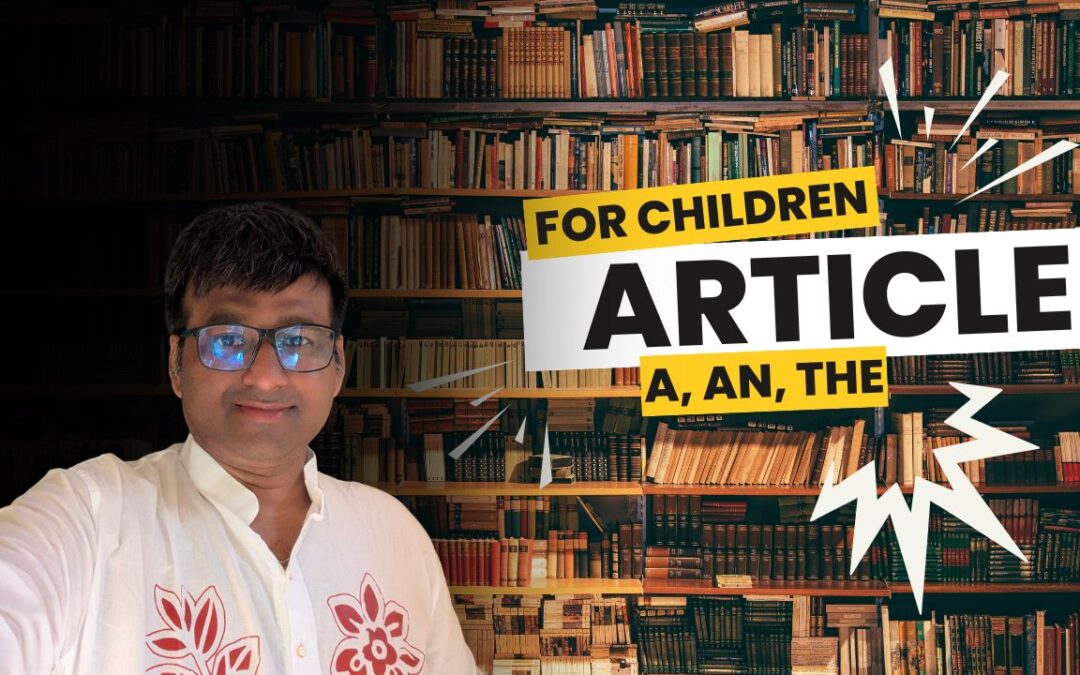Dear young learners, welcome!
Today we will explore one of the most important yet most confusing topics in English grammar — article for children.
Do you know that even fluent English speakers sometimes make mistakes with a, an, and the?
Already, I’ve covered Articles and Determiners for Kids. But here I’ll only cover the article.
After reading this guide, you’ll use every article for children perfectly in your writing and speaking.
Articles are small words, yet they make a big difference. They come before nouns and tell us whether we’re talking about something specific or general.
Let’s begin this fun learning journey together!
Table of Contents
Why Article for Children?
In simple words, an article for children is a small word placed before a noun to show whether it refers to something specific or not.
There are three articles in English:
- A
- An
- The
When you learn an article for children, you’ll notice that these tiny words can change the entire meaning of a sentence.
Example:
- I saw a dog. 🐶 (Any dog)
- I saw the dog. 🐕 (A specific dog)
See the difference? That’s the magic of articles!
Types of Articles
There are two main types of article for children:
- Indefinite Articles — A and An
- Definite Article — The
Let’s understand them one by one.
Indefinite Articles (A, An)
✅ When to Use “A”
Use “a” before words that begin with a consonant sound.
Example:
- a boy
- a cat
- a balloon
✅ When to Use “An”
Use “an” before words that begin with a vowel sound (a, e, i, o, u).
Example:
- an apple
- an elephant
- an idea
But here’s a secret that every good learner of article for children must know — it’s not the letter but the sound that matters!
Examples:
- an hour ✅ (because it starts with vowel sound ‘our’)
- a university ✅ (because it starts with consonant sound ‘you’)
❌ Common Mistakes in Article for Children
- a honest man ❌ → an honest man ✅
- an European ❌ → a European ✅
💡 Tip:
When in doubt, say the word aloud. If it sounds like it starts with a vowel, use “an”; otherwise, use “a.”
Definite Article (The)
“The” is used when we talk about something specific or already known.
Every learner of article for children must remember these key points:
✅ Use ‘The’ before:
- Unique things: the sun, the moon, the Earth
- Superlatives: the best, the tallest, the most beautiful
- Ordinal numbers: the first, the second, the last
- Rivers, seas, and mountain ranges: the Ganga, the Pacific Ocean, the Himalayas
- Holy books: the Bible, the Quran, the Gita
❌ Don’t Use ‘The’ before:
- Country names: India, France, Japan
- Languages and subjects: English, Mathematics
- Sports and meals: He plays football. She eats lunch.
Example for Practice
- The boy who won the race is my friend.
- The Taj Mahal is in India.
Understanding article for children becomes easier when you connect grammar with real life examples like these.
Bengali Pronunciation of “The”: দা (da) vs দি (di)
Now let’s understand a very common question for Bengali learners —
Why is “the” sometimes pronounced as “দা (da)” and sometimes as “দি (di)”?
1. “The” pronounced as “দা (da)”
Use “দা” when the next word starts with a consonant sound (like b, c, d, f, g, etc.)
Rule:
👉 “the + consonant sound” = pronounce as “দা”
Examples:
- the boy → দা বয়
- the cat → দা ক্যাট
- the girl → দা গার্ল
- the pen → দা পেন
- the teacher → দা টিচার
💡 Tip:
If the next word begins with a consonant, say “দা”.
It sounds smooth and natural in spoken English.
2. “The” pronounced as “দি (di)”
Use “দি” when the next word starts with a vowel sound (a, e, i, o, u).
Rule:
👉 “the + vowel sound” = pronounce as “দি”
Examples:
- the apple → দি অ্যাপল
- the elephant → দি এলিফ্যান্ট
- the orange → দি অরেঞ্জ
- the umbrella → দি আমব্রেলা
- the honest man → দি অনেস্ট ম্যান (because “honest” starts with vowel sound ‘o’)
💡 Tip:
If the next word starts with a vowel sound, pronounce “the” as “দি”.
It connects words more smoothly in speech.
Summary Table
| Pronunciation | Used When Next Word Begins With | Example in English | Bengali Pronunciation |
| দা (da) | Consonant sound | the boy | দা বয় |
| দি (di) | Vowel sound | the apple | দি অ্যাপল |
Easy Trick to Remember
🧠 “দি” loves vowels,
“দা” loves consonants.
Quick Practice
Say aloud these sentences in Bengali style:
- দা পেন ইজ অন দা টেবিল।
- দি অ্যাপল ইজ রেড।
- দা বয় ইজ প্লেইং উইথ দি এলিফ্যান্ট।
This will help you pronounce article for children more confidently and correctly.
Zero Article (When No Article Is Needed)
Sometimes, we don’t use any article for children at all. This is called the Zero Article.
✅ No Article Before:
- Plural nouns (general sense): Dogs are friendly.
- Uncountable nouns: Water is essential for life.
- Subjects and languages: She studies English.
- Meals: We have dinner at 8 p.m.
Remember: Not every noun needs an article for children — that’s part of the beauty of English grammar!
How to Choose the Correct Article for Children
Here’s a step-by-step process:
- Identify the noun — is it countable or uncountable?
- Is it something new or already known?
- What’s the first sound of the next word?
- Decide: “a,” “an,” “the,” or nothing!
Quick Chart
| Situation | Use | Example |
| Unknown singular noun | a/an | a man, an apple |
| Known noun | the | the boy |
| Unique thing | the | the sun |
| General or plural noun | — | Flowers are lovely |
Learning article for children becomes simple when you use charts like this regularly.
Advanced Usage of Article for Children
- The with adjectives: the rich, the poor
- The with instruments: play the guitar, the violin
- A/An meaning “one of many”: I need a pen.
- Repeated reference: I saw a dog. The dog was hungry.
These are advanced patterns, but with daily practice, you’ll master each article for children naturally.
Articles in Spoken English
When speaking English, using articles correctly makes you sound fluent.
For example:
- I need a glass of water, please.
- Can you pass me the book on the table?
If you forget an article for children, your sentence might sound incomplete or unnatural.
So, keep practising every day by reading, listening, and repeating sentences aloud.
Exam Preparation Tips for Article for Children
- Revise the rules daily — “A” for consonant sound, “An” for vowel sound.
- Always check whether the noun is specific.
- Avoid overusing “the.”
- Write short stories using 10 sentences with correct articles.
Common Errors
- He is a best player ❌ → He is the best player ✅
- She bought an umbrella ✅
Practising article for children daily can easily give you full marks in exams.
Practice Activity for You
Here’s a fun challenge for my dear learners:
Write five sentences without any articles.
Then rewrite them correctly by adding the proper article for children each time.
Example:
- Sun rises in east. ❌
- The sun rises in the east. ✅
This is how you make grammar learning playful and easy!
Quick Revision Chart
| Article | Used Before | Example |
| a | consonant sound | a boy, a book |
| an | vowel sound | an apple, an hour |
| the | specific noun | the sky, the Taj Mahal |
| — | general/plural | Flowers smell sweet |
Keep this chart near your study table and revise it daily. That’s how champions learn article for children!
Final Tips to Master Article for Children
- Read short English stories and underline the articles.
- Listen to English news or YouTube videos — notice how they use a, an, the.
- Talk in English every day. Even small sentences will help.
- Never be afraid of mistakes — every error teaches you something new!
Remember, mastering article for children is not hard — it’s about noticing, practising, and repeating.
👉👉👉👉👉👉👉Download Article for Children Complete Guide
My Final Suggestion
Now you’ve learned everything about article for children — a, an, and the. These three small words bring clarity, rhythm, and accuracy to your English.
So, promise yourself today: “I’ll practise one article for children every day until I use it perfectly.”
Keep learning, keep smiling, and keep growing in English confidence! For the spoken English class, contact Shovan Ghoshal sir.






